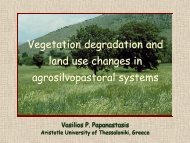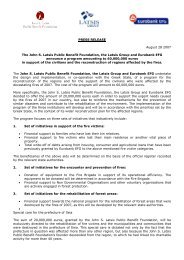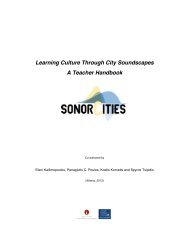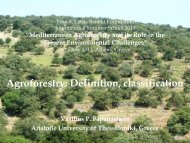presentation
presentation
presentation
Create successful ePaper yourself
Turn your PDF publications into a flip-book with our unique Google optimized e-Paper software.
Silvoarable systemsK. MantzanasLaboratory of Rangeland Ecology,School of Forestry and NaturalEnvironment, Aristotle University ofThessaloniki, Greece
Role of crops in silvoarable systemsKinds• Forage crops• Cereal crops• Root crops• Vegetables• OrnamentalsFunctions• Erosion control• Retention of soil moisture• Mulch and soil organicmatter• Nitrogen fixation
Vegetation of silvoarable systems• rich and variable• vulnerable to human practices• affected by– Land use changes– Socio-economic conditions
Degradation processes‣ Extensification or abandonment‣ Reduction of labor‣ Rural emigration‣ Uplands (mainly)‣ Intensification‣ Mechanization‣ Increase of inputs‣ Lowlands (mainly)
Traditional silvoarable systemsEconomic roleEcological roleFruitsFuel woodFeed for animalsSoil erosionSurface runoffHabitat and feedto wild animalsImprove landscape
Area covered by silvoarable systems in GreeceAgricultural area: 3,483,200 haSilvoarable area: 1,044,875 ha (32% of agricultural area)Spontaneous trees: 843,700 haCultivated trees: 201,175 ha
Classification of silvoarable systemsOverstory treesSpontaneous or plantedEvergreen or deciduousUnderstory cropsCereals, forage crops, vegetables, other crops
Tree arrangement in silvoarable systemsScatteredin linesat the edges
SAFE (Silvoarable Agroforestry For Europe)FranceItalySpainUKGreeceSwitzerlandHollandGermany
Main directionsSurvey of traditionalsilvoarable systemsin EuropeModels forsilvoarable systemsPolicy actions to supportthe maintenance and establishmentof silvoarable systems in Europe
Survey of traditional systemsData baseDescription of systemsQuestionnaires
Table 1. Main silvoarable systems at municipality of Askio.TreespeciesCropsCereals Corn Lucerne Grapes Tobacco Vegetables DrybeansOak 1 1 1 1 1 5Walnut 1 1 1 1 1 5Apple 1 1 1 1 1 5Almond 1 1 1 3WildPear1 1 1 3Poplar 1 1 1 3Elm 1 1 2Cherry 1 1Plum 1 1Hazel 1 1Nettle 1 1Blacklocust1 1Willow 1 1Total 10 2 7 4 3 4 2 32Total
Table 2. New silvoarable systems at selected areas of central and northern Greece.TreespeciesCropsCitrus 1 Corn Lucerne Grapes Sunflower 1 Vegetables Cotton 1 TotalChestnut 2 1 1 2Walnut 1 1 2Almond 1 1Holm oak 2 1 1 2Poplar 1 1Elm 1 1Cherry 1 1Olive 2 1 1 1 3Hazel 1 1Plane 2 1 1Mulberry 2 1 1Willow 1 1Total 1 3 3 1 2 4 3 17
DescriptionTable 1a. List of measurements taken in the oak-wheat systemGeographical dataDataUnitNameKsinithra, Askio, West Macedonia, GreeceArea m 2 , 10000Latitude and longitude21 o 29’ 14’’ (N) and 40 o 20’ 32’’ (W)WeatherStation latitude and longitude21 o 47’ 13’’ (N) and 40 o 17’ 56’’ (W)Total daily precipitation mm day -1 , 1.441Total solar radiation -Max. daily Air Temperature oC, 9.37Min. daily Air Temperature oC, 3.79VPD (daily average) -Wind speed (daily average) m s -1 , 2.27
Management input dataPlot size -Plant densities n m -2 , 0.002Planting/ sowing timespontaneousPlanting depth -Spacing within Row (tree only)scatteredSpacing between Row (tree only)scattered
Table 1b. Further dataDataTree and crop characteristicsUnitPlant speciesQuercus pubescens and WheatPlant varietycrop: durum wheatRooting depth -Crop characteristicsSeed weightkg/ha, 220 (sowing rate)Length of growing period Days, 265Time of canopy closureDOYTree characteristicsInitial height -Tree crown size -Tree canopy height DOY, 112 m, 12.99Tree diameter DOY, 112 cm, 54.58
Tree phenologyVegetative stage before floweringBudburstStart of floweringEnd of floweringDOYDOYDOYMaintenanceIrrigation -FertilizationDOY(2001), 319, (20-10-0) 100 kg/haDOY(2002), 120, (34.5-0-0) 100 kg/haWeeding DOY, 120Pruning of trees DOY(2001), 300Thinning -HarvestDate DOY, 189Crop yield t ha -1 , 1.5Tree yield (Fruit/nut) -Residual (dry weight) -
Questionnaires264 face-to-face interviews were undertaken to determinefarmers’ perceptions of silvoarable agroforestry across 14sample areas in seven European countries (Graves et al.2008)
The perceptions of farmers varied with area and according to theenvironmental and socio-economic contextsBenefitsFarmers in Mediterranean areas felt that the principal benefit ofsilvoarable systems was to improve farm profitability, whereasfarmers in Northern Europe highlighted environmental benefits.In terms of negative attributesfarmers in Mediterranean Europe prioritised intercrop yield declinewhereas farmers in Northern Europe felt that complexity of workand mechanisation were the most important constraints.Compared to Mediterranean farmers, farmers in Northern Europeenvisaged systems with wider alleys and lower tree densities. Thisdifference was associated with the use of larger machinery.
Models created during SAFE projectHi-SAFE INRA, ICRAF, NERCYield-SAFEPlot-SAFECRANFarm-SAFEFALGis-SAFEWU, CRAN, INRAINRA, APCALer-SAFEINRA, APCA(By C. Dupraz)
Yield-, Plot- and Farm-SAFEPlot-SAFEFarm-SAFEBiophysicalModelYield-SAFEBiophysicaldataPlot-scaleeconomicmodelFarm-scaleeconomicmodel
Plot-SAFECrop - management( i.e crop rotation, date of tree planting)Plot - management( i.e discount rate, labour cost)WeatherdataCropparametersTreeparametersSoilsparametersBio -physicalmodel(daily timestep)Crop yieldTree yieldSilvoarablesystem yieldsArablesystem yieldsForestsystem yieldsEconomicmodel at aplot scale(annual timestep)Crop financeTree valueTree grantsTree costsModified managementSummary of outputs
Options and resultsUpscaling results sheetSystemselectionPlantingcalendarEconomicoptionsSensitivityOne-hectareresultsFarm-SAFEanalysisUnit-scaleresultsFarm-scaleresultsArablesystemArablefinancePlot 1-4Calculation ofarableeconomicsUnit 1-4Calculation ofarableeconomicsFarmCalculation ofarableeconomicsAgroforestrysystemCrop optimisationCalculation ofagroforestryeconomicsCalculation ofagroforestryeconomicsCalculation ofagroforestryeconomicsTreevalueTreegrantTreecostCalculation offorestryeconomicsCalculation offorestryeconomicsCalculation offorestryeconomicsForestrysystemProductions and LERGraphic results
Land Equivalent Ratio (LER)LER poplar_wheat = (PoplarAFS/ PoplarMono)+ (WheatAFS/ WheatMono)LER: The area required from a mono-crop toproduce the same quantity with a mixed system(silvoarable)LER poplar_wheat = (PoplarAFS/ PoplarMono)+(WheatAFS/WheatMono)=(0.6/1)+(0.6/1)=1.2(By C. Dupraz)
Production and LERExample of cummulative LER for wild cherry andwheat/wheat/wheat/maize at Dampierre France developed using PlotSAFE1.601.40arable main productiontimbercumulative LER1.201.000.801 6 11 16 21 26 31 36 41 46 51 560.600.400.200.00
LER-SAFEGeneration of AF yields with threelevels of LER:pessimistic : 1.0intermediate : 1.2optimistic : 1.4Different LER can be definedWith or without sub-products (straw, fuelwood, tree fruits...) -new equation available -With or without the thinning products of the trees (a specialsub-product)With or without the annual crop component when the cropcultivation is no longer profitable (too low yields)
Range of hypotheticalLERs (1 to 1.4)Site specific actual yields(trees and crops)Ler-SAFESite specific Time series of tree and crop productivityFarm-SAFESensitivity of profitability to biological efficiency
Final densities (stems/ha) LER = 1,4 LER = 1,2 LER = 1,0AgroforestryForestryRYtreesRYcropsRYtreesRYcropsRYtreesRYcrops100 1 0,4 0,85 0,35 0,7 0,3Walnut58 100 0,7 0,7 0,65 0,55 0,6 0,4400,55 0,85 0,45 0,75 0,4 0,690 0,9 0,5 0,75 0,45 0,6 0,4Cherry50 100 0,6 0,8 0,5 0,7 0,45 0,55300,5 0,9 0,35 0,85 0,3 0,7143 0,8 0,6 0,7 0,5 0,6 0,4Poplar77 200 0,6 0,8 0,5 0,7 0,45 0,55520,45 0,95 0,35 0,85 0,3 0,7
Initialwidth ofthecroppedbayInitialcrop area(%)Density(stems/ha)initialfinalThinnedtrees(stems/ha)HighfertilityRevolution (years)MediumfetilityPoorfertilityWalnutCherryPoplar12 m 86 % 143 100 4324 m 92 % 77 58 1936 m 95 % 52 40 1212 m 86 % 143 90 5324 m 92 % 77 50 2736 m 95 % 52 30 1212 m 86 % 143 143 -24 m 92 % 77 77 -36 m 95 % 52 52 -46 years 53 years 60 years50 years 55 years 60 years19 years 22 years 25 years(By C. Dupraz)
ForestryAgroforestryFinaldensity(stems/ha)Volume ofthe stem atharvest(m3/tree)Volume of the stem at harvestFinal(m3/tree)density(stems/ha) LER = 1,4 LER = 1,2 LER = 1,0100 0,90 0,77 0,63Walnut 100 0,958 1,09 1,01 0,9340 1,24 1,01 0,9090 1,00 0,83 0,67Cherry 100 150 1,20 1,00 0,9030 1,67 1,17 1,00143 1,62 1,42 1,22Poplar 200 1,4577 2,26 1,88 1,6952 2,51 1,95 1,67(By C. Dupraz)
Site specific actual yields(trees and crops)Site specific potential yields(trees and crops)Yield-SAFEOne site-specific LERSite specific Time series of tree and crop productivityFarm-SAFESensitivity of profitability to biological efficiency?
– 19 Landscape Test Sites (LTS) were developed for farmscalemodelling, 9 in Spain, 7 in France and 3 in Holland– For each LTS a hypothetical farm was developed andmodelled
– The farms contain between one and four land units dependingon the complexity of the landscape– different levels of productive potential are possible on eachland unit– Precipitation and air temperature were assumed to be identicalacross all land units on each given LTS– But the land units could be differentiated by radiation, soiltexture and depth
How many plots?• Holland (3 plots)• Spain (19 plots )• France (20 plots)• Total (42 plots) x 2 agroforestry densities• 82 LERS
• Agroforestry tree density - 50 or 113 tree ha-1• Forestry tree density:Spain: oak 800, 600 or 400 trees ha-1; pinus 800trees ha-1France: poplar 204 trees ha-1; walnut 210 trees ha-1;wild cherry 816 trees ha-1The Netherlands: poplar 400 trees ha-1; walnut 400tees ha-• Length of crop rotation in agroforestry plotInfluenced by interplay of economics and yielddecline
Stand volume (m3 ha-1)500.0450.0400.0350.0300.0250.0200.0150.0100.050.00.01 4 7 10 13 16 19 22 25 28 31 34 37 40 43 46 49 52 55 58Years (a)(By C. Dupraz)
m3 ha-1CMP_LU2CHT_LU3CHT_LU1CHD_LU2BEN_LU1Timber volume (incl. thinnings) for walnut in theNetherlands and France160140120100806040200Walnut forest(NL=400;F=210)Walnut SAF 113Walnut SAF 50
m3 ha-1Timber volume (incl. thinnings) for pinus in Spain180160140Spain pinus forest (800)Spain pinus AF 113Spain pinus AF 50120100806040200CAM_LU1 FON_LU2 OLM_LU1
m3 ha-1TOR_LU2TOR_LU1PAR_LU3PAR_LU2PAR_LU1OLM_LU3OLM_LU2OCA_LU1FON_LU1CAR_LU2CAR_LU1CAM_LU2ALM_LU2ALM_LU1ALC_LU2ALC_LU1Timber volume (incl. thinnigs) for Oak in Spain160140120Spain oak forest (800,600,400)Spain oak AF 113Spain oak AF 50100806040200
m3 ha-1VIT_LU1SAN_LU4SAN_LU3SAN_LU1FUS_LU3FUS_LU1DAM_LU2DAM_LU1CMP_LU1CHT_LU4CHT_LU2CHD_LU1Timber volume (incl. thinning) for wild cherry inFrance500450400350300250200150100500Forest wild cherryWild cherry SAF 113Wild cherry SAF 50
m3 tree-1Oak tree growth (60 years)1.210.80.6Oak - Forest600Oak - SAF113Oak - SAF500.40.20Years (a)
m3 tree-1Individual tree volumes2.521.51Walnut - SAF50Walnut - SAF113Walnut - Forest210Walnut - Forest4000.50BEN_LU1 CHD_LU2 CHT_LU1 CHT_LU3 CMP_LU2
LERRanked LERs (descending order)2.502.001.501.00113 trees ha-150 trees ha-10.500.001 4 7 10 13 16 19 22 25 28 31 34 37 40Rank
Yield (t ha -1 )Effect of optimisation on AF tree growth for poplar inSilsoe350300250agroforestry tree growth (non-optimised crop rotation)agroforestry tree growth (optimised crop rotation)2001501005001 3 5 7 9 11 13 15 17 19 21 23 25 27 29Years (a)
Volume (m 3 ha -1 )Actual yield of poplar60504030Measured forestryPredicted forestryMeasured silvoarablePredicted silvoarable201000 2 4 6 8 10 12Time from planting (year)
Timber volume(m 3 ha -1 )Actual yield of poplar in Mediterranean region2502001501005000 2 4 6 8 10 12 14 16Time from planting (year)
Timber volume(m 3 ha -1 )Actual yield of poplar in Mediterranean region2502001501005000 2 4 6 8 10 12 14 16Time from planting (year)
Tree biomass(kg tree -1 )Potential oak in Mediterranean region60040020000 10 20 30 40 50Time after planting (year)
Timber volume(m 3 tree -1 )Potential yield of cherry in Atlantic region432100 10 20 30 40 50 60Time after planting (year)
Timber volume(m 3 tree -1 )Potential yield of Pinus in Mediterranean region0.80.60.40.200 10 20 30 40 50Time after planting (year)
Hi-SAFE : a process-based tree-crop interaction modelModelling different systemsWalnutWild CherryPoplarsMediterranean OaksWinter and summerannual crops, grass,alfalfa(By C. Dupraz)
Hi-SAFE goals• Process-based model of tree-crop interactions• Temperate silvoarable systems• 4 tree species; main European crop species• Predicting LERs (pure crop and pure tree control required)
Some features of the Hi-sAFe modelManagement options included :•Strategic options (at the inception) :•tree plantation design including tree row azimuth,initial tree-crop distance, initial crop rotation•Tactical options (triggered at the year time-step) :•thinning, branch pruning, canopy thinning, rootpruning, cropped area size, crop precisionmanagement
Requirements for a new type of modelBelow-groundOpportunistic and reactive treeand crop root systemsFigure 14: exponential decrease in rootlength density with depth and distanceTopology of major coarse rootsrequired to simulate rootpruning
Requirements for a new type of modelAbove-groundOpportunistic and reactive treecanopies to available space andlightTree canopy structure required tosimulate both branch pruning andcanopy thinningDynamics of light penetrationessential at the day time step(impact on crop physiology)
Hi-SAFE parameters• No site specific parameters (no local calibration)• Allows cross-validation between experimental sites Tree species parameters (40) Crop species parameters (150)
The Hi-sAFe scene3D above-ground interaction3D below-ground interactionAny number of trees includedThe crop is represented by multipleparallel instances of the crop modelThe tree-row vegetation isrepresented by additional instances ofthe crop model (bare soil, mulch,grass available)
Hi-SAFE allows to understand the tree-crop interaction processesWhat explains the measured productivity ?What are the limited factors for productivity?Water ?Light ?Nitrogen ?
Water uptake (by voxel) in theAgroforestry treatment
Predictions of the model…• Interception of leached nitrates by deep tree roots• Injection of carbon in deep horizons of the soil by treeroot turn-over• The heterogeneity of the crop yields in the plot• The light heterogeneity within any agroforestry stand• The crop productivity and heterogeneity within anyagroforestry stand
Hi-sAFe predicts the tree and crop root patternsthat results from the competitionAgroforestryForestryNo tree roots zone
Crop yield (%)Timber volumePrediction of crop and tree productivityTree Plantation1008060Tree Harvest8070605040402000 TimePure cropIntercropsTimber volume3020100Wild Cherry 80 trees/ha (pessimistic LER = 1.1)
Crop yield (%)Timber volumePrediction of crop and tree productivityTree Plantation1008060Tree Harvest8070605040402000 TimePure cropIntercropsTimber volume3020100Wild Cherry 80 trees/ha (optimistic LER=1.3)
4 x 4 kmFrom plot to farm and regionThe up-scaling concept for scenario studies1) Assessing the feasibility at farm scale- what happens if the farmer is uptaking agroforestry onhis farm? profitablility2) Assessing the feasibility at landscape scale- what are the effect of implementation of agroforestry? soil erosion, nitrate leaching, groundwaterrecharge, carbon sequestration, landscapediversity?3) Assessing the feasibility at European scale- where is it possible in Europe to implementagroforestry?- what would be the effect? soil erosion, nitrateleaching, and landscape diversity
Regional test areas FarmsDigital elevation modelLand unitsLand coverSoil available watercontent (mm)RadiationFarm economic data(European and nationalstatistics)
Multicriteria assessmentEconomic indicators:- Land equivalent ratio- NPVEnvironmental indicators:- groundwater recharge- nitrate leaching- CO 2 sequestration- erosion- landscape diversityScenarios:- where should AF be recommended (productive / non-productive areas)?- how much of the farm should be converted to agroforestry?- level and modalities of subsidy paymentsLand units
European scaleTo identify target areas in arable land to implementnew silvoarable agroforestry systems in Europe.GIS-analysis based on digitally available geo-information„coarse grained“ assessment (1km x 1km) based on environmental analysis:1) productive tree growth for:- Juglans hybrids (Juglans regia; European walnut)- Prunus avium (Wild cherry)- Populus ssp. (Poplar)- Pinus pinea (Italien stone pine)- Quercus ilex (Holm oak)2) risk areas (soil erosion, nitrate leaching, low landscapediversity)(By J. Palma)
Methods (1)Target regions were defined at the intersection between(i) regions where productive tree growth in an agroforestrysetting is possible and(ii) regions where environmental problems exist whichagroforestry can help to solve.Europearable landproductive tree growthTargetregionenvironmental risk
Methods (2)Europeproductive tree growthTargetregionarable landenvironmental riskRegions where productive tree growth in an agroforestrysetting is possible based on the tree growth requirements:Soil European Soil Data Base, map 1:1’000’000Climate CRU University of East Anglia, resampledto 1km 2 gridsTopography U.S. Geological Survey's (USGS)EROS Data Center, 1km resolution
Data InputGeoreferencing & resamplingDataProcessingDatabaseData type:•Vector•Raster•TablesQueryCheckData OutputCriteriaSpatial reference: PELCOM(Pan European Landcover)•Scale : European Continent•Coordinate system : Pelcom•Resolution: 1100 m•Window or envelop setup
Maps of the environmental requirements of Juglans hybridspotential area for walnut:15% of the arable landParisViennaValladolidToulouse
Agroforestry trees for temperate Europepotential area for walnut:15% of the arable landpotential area for poplar:34% of the arable landpotential area for wild cherry:18% of the arable landArable land covers about 35 % (170 million ha) of the european area
Agroforestry trees for mediterranean Europepotential area for Italien stone pine :4% of the arable landpotential area for holm oak:10% of the arable landArable land covers about 35 % (170 million ha) of the european area
Methods (3)Europeproductive tree growthTargetregionarable landenvironmental riskRegions where environmental problems exist whichagroforestry can help to solvebased on environmental problems:high nitrate concentration in the groundwaterNitrate Vulnerable Zone (EU directive)high risk for soil erosionEU-project PESERAlow landscape diversityPELCOM and CORINE land cover maps
Regions with environmental problems>50 mg NO 3 /l>5t/ha/a soil loss25km 2 squares with >50%arable land~ 11 % of arable land~ 5 % of arable land ~ 68 % of arable land
Methods (4)Europeproductive tree growthTargetregionarable landenvironmental riskTarget regions are those where agroforestry is possiblewith a productive tree growth and where environmentalrisks call for agroforestry. Overlaying(1) productive tree growth(2) arable land(3) environmental risk
Target areas for silvoarable agroforestryNorth-GermanySW-FrancePo-Valley
Results (1)1) Arable land: 171.000.000 ha (35% of european area)2) Potential distribution of selected tree species (arable land)Suitable for at least one tree species: 90 million ha (53%)3) Risk areas (in arable land)At least one environmental risk: 138 million ha (81%)•8 million ha (5%) soil erosion (99% suitable for trees)•50 million ha (30%) nitrate leaching (58% suitable for trees)•116 million ha (68%) landscape diversity (87% suitable for trees)(By J. Palma)
Results (2)Tagret areas= arable land + productive tree growth + risk areas65 x 10 6 ha ( 38% of arable land)ProductiveAgroforestry systemscould mitigateevironmental risks‣58% of area with highnitrate leaching (30x10 6 ha)‣44% of area with uniformArable landscape (42x10 6 ha)‣75% of area with high‣soil erosion (6x10 6 ha)(By J. Palma)
Policy aspectsTraditional systemsThere is not any specific measureMaintenance of trees and hedgerows under agro-environmentalmeasures and good agricultural practicesCropped areas with scattered trees are eligible for SinglePayment Scheme (SPS) in most cases
Policy aspectsNew agroforestry systemsArticle 44 of Regulation (EC) No 1698/2005 for the firstestablishment of agroforestry systems on agricultural land approvedfrom the Greek Ministry of Rural Development and FoodRational for interventionOver the last years it has been noted that the conservation oftraditional agroforestry systems is necessary for maintaining goodsoil condition, increased biodiversity, improved rural landscape, andrural life in mountain areas. Also, the development of new systemsthat properly combine forest and agricultural products is imperative
Objectives of the measureTo support the establishment of agroforestry systems for their highsocial and ecological value in combination with extensiveagriculture and forestry resulting in the production of valuable woodand other forest productsTo protect the traditional agroforestry systems, for ensuring themaintenance of good soil condition, biodiversity and the rurallandscape as well as for providing economic support to the ruralpopulation of the hilly and mountainous areas. Also, it is considerednecessary to establish new systems capable of combining forest andagricultural production and being sustainable
Scope and actionsThe measure will be applied in continental Greece that isPeloponnesus, Sterea Ellada, Epirus, Thessaly, Macedonia andThrace, with emphasis in areas with large agriculturalmonocultures or in areas with specific environmental problemsThe smallest eligible area will be 0.5 haEligible costs:To buy the treesTo buy the stakesTo buy the tree sheltersTo plant the treesTo set up the tree shelters and stakes
Agricultural useThe understory could be agricultural crop or pasture. Agriculturalcrops include arable crops, vegetables and other garden crops(excluded tree crops and vines). Pastures include private areasused for animal grazingDensities of plantingIn order to achieve the appropriate management of agroforestrysystems, trees will be planted in rows. The least distance betweenrows must be 10 meters and between the trees at the same row, 4meters. The maximum number of trees must not be greater than200 trees per hectare (especially for the walnut trees thesenumber must not be greater than 100 trees per hectare)
Level of supportSupport will only cover establishment costsSupport shall be limited to the maximum rate laid down in the annexof Regulation 1698/2005:Intensity of aid for establishment costs:80 % of eligible costs in the areas referred to in Article 36 (a) (i)(ii) and (iii) (mountain areas, in areas with handicaps otherthan mountain areas, and in Natura 2000 and WFD areas)70% of eligible costs in other areasTotal cost: 3,304,669 €Number of hectares under new agroforestry systems: 3,300 ha
ConclusionsThe implementation of Agroforestry systems in Europeanarable landscapes could:• reduce environmental risks• be used throughout all climatic zonesThe GIS-tool developed in this study could help farmer andpolicy makers to introduce new AF systems at Europ. scaleData quality and data availability at the continental scale isstill quite poor, a good European environmental dataset can beuseful for this type of studiesScale 1x1 km general picture. Does not give an indication atsite scale (e.g. different microclimatic condition)
Spontaneous evergreen tree speciesQuercus coccifera)
Olea europeaSpontaneous evergreen tree species
Spontaneous deciduous tree speciesSalix sp.Quercus trojana
Quercus trojanaSpontaneous deciduous tree species
Spontaneous deciduous tree speciesQuercus macedonicaQuercus macedonica
Spontaneous deciduous tree speciesSalix sp.Quercus macedonica
Spontaneous deciduous tree speciesQuercus cerrisQuercus cerris
Quercus macedonicaSpontaneous deciduous tree speciesQuercus macedonica
Quercus macedonicaSpontaneous deciduous tree speciesQuercus macedonica
Spontaneous deciduous tree speciesQuercus trojana
Spontaneous deciduous tree species
Quercus trojanaSpontaneous deciduous tree species
Quercus trojanaSpontaneous deciduous tree species
Quercus cerrisSpontaneous deciduous tree species
Salix sp.Spontaneous deciduous tree species
Quercus macedonicaSpontaneous deciduous tree species
Spontaneous deciduous tree species
Spontaneous deciduous tree species
Quercus frainetto(Albania)Spontaneous deciduous tree species
Planted evergreen tree species
Planted evergreen tree species
Planted deciduous tree speciesWalnut trees(Juglans regia) withvarious crops
Planted deciduous tree speciesWalnut trees(Juglans regia) withvarious crops
Planted deciduous tree speciesWalnut trees(Juglans regia) withvarious crops
Planted deciduous tree speciesWalnut trees(Juglans regia) withvarious crops
Planted deciduous tree speciesWalnut trees(Juglans regia) withvarious crops
Planted deciduous tree speciesWalnut trees(Juglans regia) withvarious crops
Planted deciduous tree speciesWalnut trees(Juglans regia) withvarious crops
Planted deciduous tree speciesWalnut trees(Juglans regia) withvarious crops
Planted deciduous tree speciesPoplar trees(Populus sp.) withvarious crops
Planted deciduous tree speciesPoplar trees(Populus sp.) withvarious crops
Planted deciduous tree speciesPoplar trees(Populus sp.) withvarious crops
Planted deciduous tree speciesPoplar trees(Populus sp.) withvarious crops
Planted deciduous tree species
Planted deciduous tree species
Planted deciduous tree speciesCeltis austarlisUlmus sp.Ulmus sp.Ulmus sp.
Planted deciduous tree speciesCorulus sp.Apple treesApple treesPeach trees
Planted deciduous tree speciesAlmond treesSalix sp.Peach trees
Planted deciduous tree speciesAlmond treesUlmus sp.
Planted deciduous tree speciesApple trees
Planted deciduous tree speciesApple trees
Planted deciduous tree speciesChestnut trees
Modern agroforestry: Planted deciduous tree species
Modern agroforestry: Planted deciduous tree species
Modern agroforestry: Planted deciduous tree speciesTree height at wheat plot4,03,53,02,52,01,51,00,50,0Walnut Cherry Celtis1 2 3 4 5 6 7 8Years
Modern agroforestry: Planted deciduous tree speciesTree diameter (mm) at wheat plot90,080,070,060,050,040,030,020,010,00,0Walnut Cherry Celtis1 2 3 4 5 6 7 8Years
Wheat plotMay2004August2004May2004August2004
Modern agroforestry: Planted deciduous tree speciesTree height at maize plot6,05,04,03,02,01,0WalnutCherry0,01 2 3 4 5 6 7 8Years
Modern agroforestry: Planted deciduous tree species120,0Tree diameter (mm) at maize plotWalnutCherry100,080,060,040,020,00,01 2 3 4 5 6 7 8Years
Maize plotMay2004August2004April 2004August2004
Conclusions• Silvoarable systems are very rich and viable• Extensification and intensification are the main reasonsfor their degradation• Farmers must understand the ecological role of thesesystems• Special incentives must be added to farmers income inorder to keep the existing trees in their farms andestablish new silvoarable systems
Thank you
1. What do you think will be the future oftraditional silvoarable systems in Europe?2. Are subsidies necessary for the widespreadestablishment of silvoarable systems inEurope?








